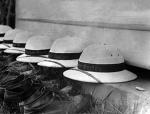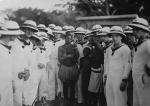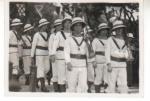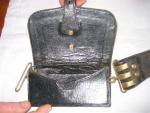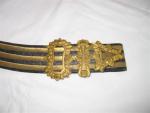-
Posts
1,761 -
Joined
-
Last visited
-
Days Won
3
Content Type
Profiles
Forums
Blogs
Gallery
Events
Store
Everything posted by Stuart Bates
-
Hi Mervyn, a couple of points - 1. the yellow band around the waist of the cap should have a central blue stripe (the 21st Lancers had an all yellow band). 2. the horsehair plume is rather long for an OR's cap but perhaps it is a Sergeant's or Officer's plume (it is a replacement yes?). The 17th originally had white horsehair plumes and in 1874 adopted black plumes, but in 1883 reverted to white plumes. In 1876 cocks' feather plumes were authorised for levees and Review Order but it was horsehair for all other occasions. And after 1900 the 17th had a white top to the cap - cloth for officers and patent leather for ORs. I don't think I would attempt to clean up the waist band. At least not without an expert opinion, as too often one can just make things worse. What has caused the stain as quite likely someone on the forum could help. I would like to see an interior and a rear shot but otherwise you have done a good job of putting this gem back together. Cheers, Stuart
-
The rank badges would be on the shoulder straps so I think the badge would be his Corps or Regiment. Pity we can't see the flash. Helmets could vary in shape from manufacturer to manufacturer and depending on what equipment they employed in the manufacturing process. Originally they were made by hand on hat blocks and these blocks could vary quite markedly. I don't know when machine manufacture came in or how the process worked. I did write to one of the remaining helmet makers but got no response. Gieves seem to have had a monopoly on the Royal Navy trade but there were many suppliers to the army - Hawkes, Christys, Ellwood etc. and many smaller makers who supplied no-name items to military outfitters who then often put their own name to the helmet. Stuart
-
Leigh, this helmet was, I think, called the "Standard Pattern" but looks very much like the "Pith Hat" which first appeared as a photograph in the 1900 DRs but was never further described. It isn't a Wolseley however. I have this photo taken in 1937 of sailors of HMS Tarantula when in Canton. The helmets look very much like those worn by German sailors of the period - who copied whom? Stuart
-
Leigh, I have Mike Chappell's book but after checking John Mollo did not think it worthwhile to go any further, especially as I was fighting my ISP because my email/webmail has been out of commission since yesterday morning. My ISP is updating their webmail and doing it online and it doesn't work! Unbelievable! For some reason large attachments kill my email through Outlook Express so I tried Thunderbird with the same results. Anyway this is not a technical forum. Stuart
-

King's Dragoon Guards
Stuart Bates replied to Stuart Bates's topic in Great Britain: Militaria: Badges, Uniforms & Equipment
Leigh, I use perspex tubes which I have now covered with black stockings to give a better look. I had little cushions made up and these fit in the crown of the helmet and cushion (yes I meant that) the helmet from the edge of the tube as well as distribute the weight better. My photographer friend Nick was up here yesterday to photograph that ADC's Wolseley and so I had him do the collection as a whole as well. When he has finished editing the photos I will post in the collections area. Stuart -

King's Dragoon Guards
Stuart Bates replied to Stuart Bates's topic in Great Britain: Militaria: Badges, Uniforms & Equipment
Mike, I don't know to what unit that shako belongs but it is early Victorian period. I bought it from Blunderbuss in London many years ago but they could not identify it and I haven't been able to since. It might be a Yeomanry unit but, as I say, I haven't been able to identify it. Tomorrow I will look at it again and probably post it as a separate topic for ID. Someone out there will know :) -

King's Dragoon Guards
Stuart Bates replied to Stuart Bates's topic in Great Britain: Militaria: Badges, Uniforms & Equipment
Mervyn, I hope to get the collection professionally photographed as a whole this week. When it's done I will post. Stuart -

King's Dragoon Guards
Stuart Bates replied to Stuart Bates's topic in Great Britain: Militaria: Badges, Uniforms & Equipment
Mike, you mean this one? It is the 1818 pattern and to the 2nd Dragoon Guards. It's a heavy bugger so the DGs must have been large men. -

King's Dragoon Guards
Stuart Bates replied to Stuart Bates's topic in Great Britain: Militaria: Badges, Uniforms & Equipment
Very funny, Leigh. I guess that I have just been lucky but I would love to see your collection. I only collect headdress, but I think your collecting ranges much wider. Stuart PS: Fuller's London Pride and/or Double Diamond -
Mervyn, found this in the 1864 DRs - "Shoulder Belt - black morocco, with three rows of gold embroidery for Director General; with two rows for Inspector and Deputy Inspector General of Hospitals, and black patent leather for all other ranks..." Now the 1874 DRs state that for a Surgeon Major that "on state ocassions, at balls and in Cavalry regiments" the gold embroidered belts/pouches were to be worn. At other times a plain black Morocco belt and pouch. Army Hospital corps had a brown Morocco leather belt and pouch. The 1883 DRs for the Army Hospital Corps give a brown belt but a black pouch with the Royal Cypher and Crown in gilt on the centre of the flap. My head hurts! The 1900 DRs don't mention any belt/pouch which does not have gold stripes so yours is much earlier. I will attempt to dig up more information later but hope someone more au fait with the subject will step in Stuart



